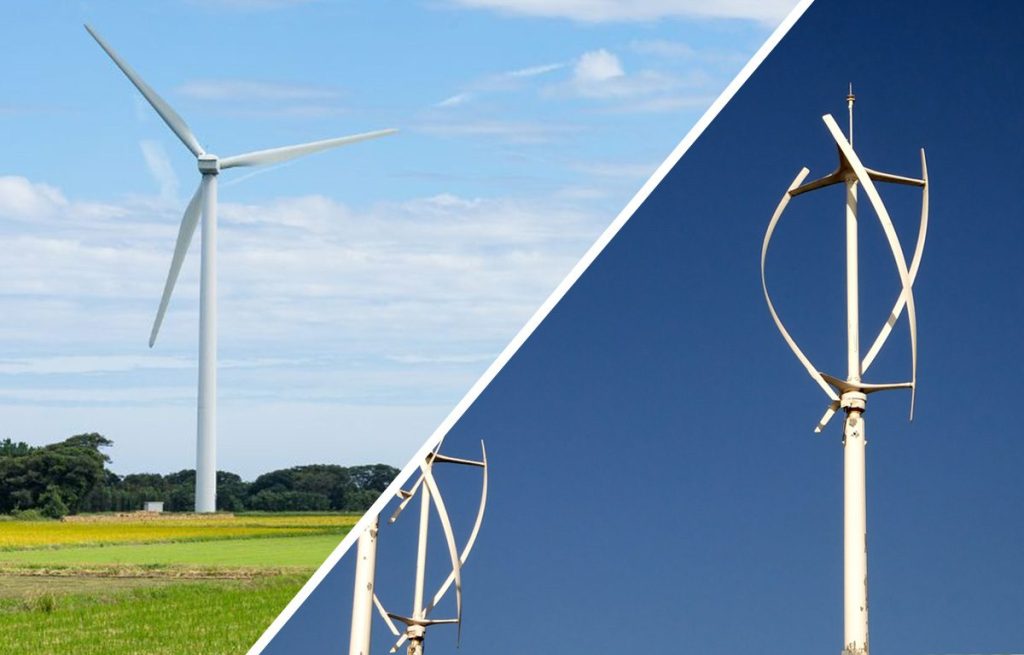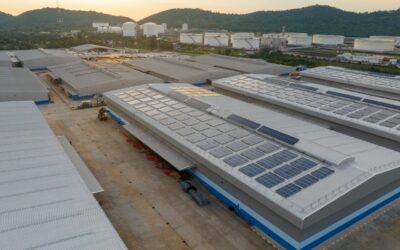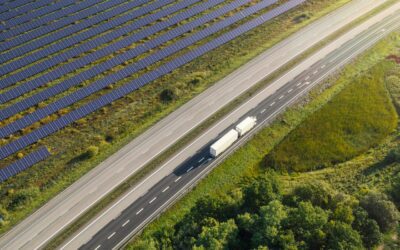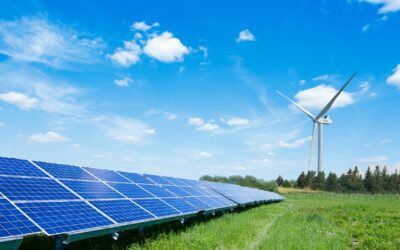The Two Main Types of Wind Turbines Explained
For centuries, researchers and engineers have been building and testing creative wind turbine designs to discover the best way to generate renewable, clean energy from wind power. While there are a wide variety of wind turbine types, modern wind turbines fall into two basic categories of models: horizontal-axis wind turbines (HAWT) and vertical-axis wind turbines (VAWT). Vertical-axis turbines have some unique advantages due to their convenient design, but horizontal-axis turbines remain far more effective models for utility-scale wind power generation.
Horizontal-Axis Wind Turbines
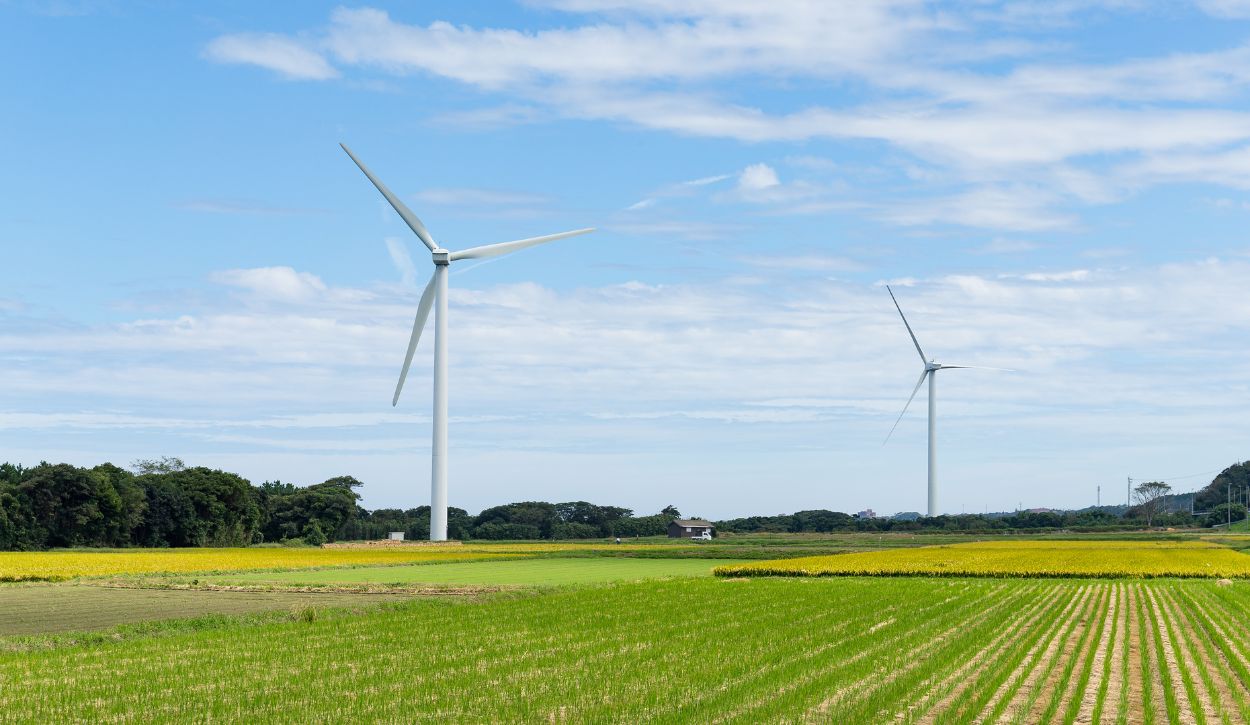
Two utility-scale, horizontal-axis wind turbines
The vast majority of utility-scale wind turbines are horizontal-axis, gear-based models. This wind turbine design features blades that are parallel to the ground, resembling a simple windmill. The drivetrain, including the gearbox and generator, sits behind the rotor blades in a section called the “nacelle.” All the main components of this turbine design are elevated on a tall steel tower. The yaw system is responsible for orienting the turbine according to the direction of the wind, and a brake system ensures the turbine comes to a halt during extreme wind speeds that could damage the turbine.
Newly installed land-based turbines in the U.S. have an average power capacity of 3.2 MW (megawatts), making them an effective supplement to power plants in windy regions.1 Offshore wind turbines are capable of much higher power capacities, harnessing strong winds over the ocean. Wind farms comprised of HAWTs are increasingly common sights in the U.S. as wind energy becomes an increasingly important power source for electricity grids across America.
How big are horizontal-axis turbines?
The average height of land-based wind turbines in the U.S. is 100 meters (328 ft), with blades over 200 feet long.2 Offshore wind turbines are even larger. The largest wind turbine in the world is installed offshore in China – a 16 MW (megawatt) machine over 500 feet tall, with 400-foot blades.3 Learn more about the sizes and dimensions of utility-scale wind turbines in our guide.
Advantages of Horizontal-Axis Turbines
HAWTs are the most efficient turbine models, reaching strong winds at high altitudes thanks to their vast dimensions. They also rely on aerodynamic blades that minimize drag while sweeping an expansive area for maximum power output. As the world continues to invest in renewable energy sources, we can expect an increase in both onshore and offshore wind farms made up of horizontal-axis turbines.
Disadvantages of Horizontal-Axis Turbines
Horizontal-axis wind turbines are known for their power and efficiency but come with a few disadvantages. The primary design weakness is that they operate in a narrower range of wind conditions than vertical axis turbines. They must be oriented in the right direction to capture wind power and struggle to produce power in low wind speeds. Additionally, the horizontal-axis design is vulnerable during high wind speeds and must brake to avoid damage.
The sheer size of HAWTs is an advantage in terms of performance, but this also poses maintenance, logistics, and installation challenges. Because the electrical generator is situated at the top of the steel tower, these turbines are difficult to maintain and fix in the event of a problem. And constructing wind farms requires significant planning and coordination efforts. Onshore and offshore wind energy projects necessitate close collaboration with trusted transportation and construction companies that can help ensure timeliness and safety.
Vertical-Axis Wind Turbines
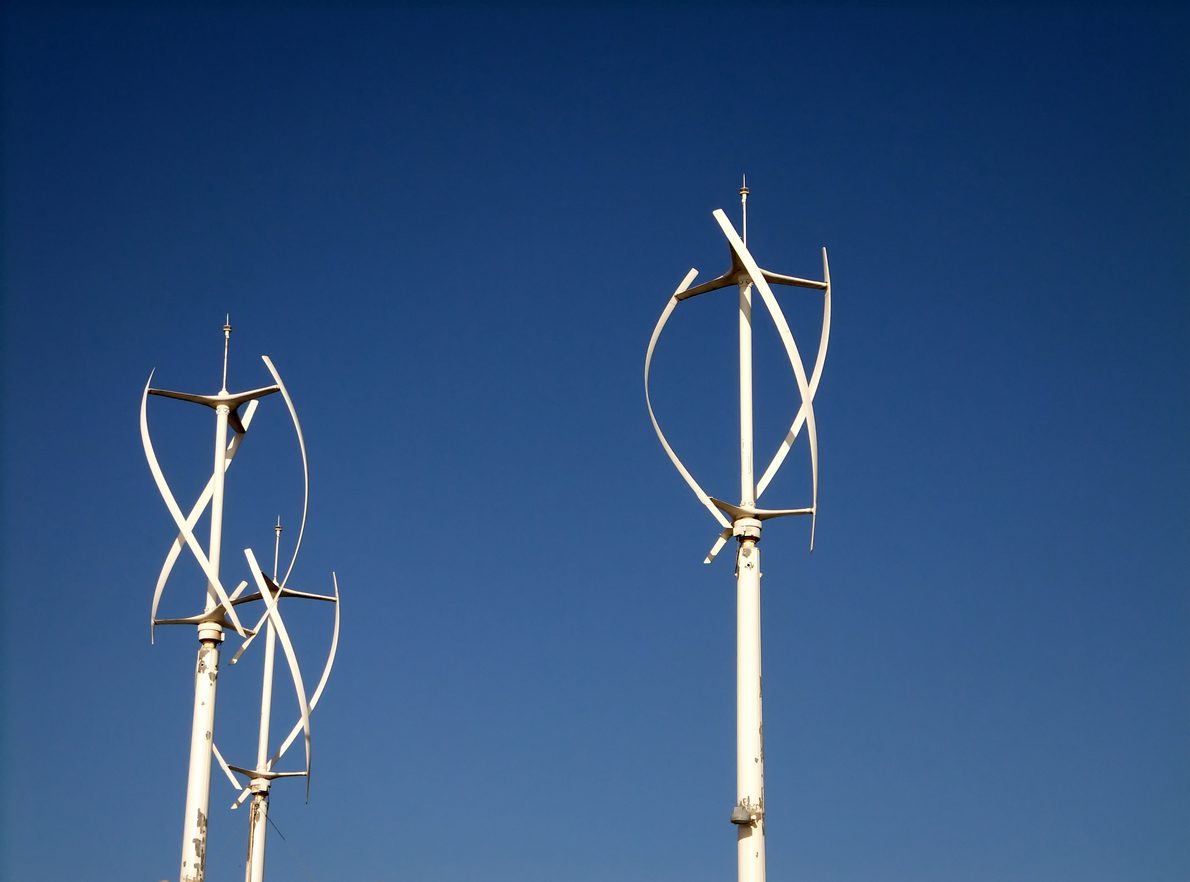
Three helix-shaped Darrieus wind turbines
Vertical-axis wind turbines, or VAWTs, are far less common than HAWTs. Their unique design relies on blades that are perpendicular to the ground, and a gearbox and generator that sit below the rotor instead of behind it. These models are more likely to be found in residential settings than in wind farms, as they are small wind turbines that don’t produce as much power. There are a number of design variations among vertical-axis turbines, two of the most common being the Savonius and Darreius models.
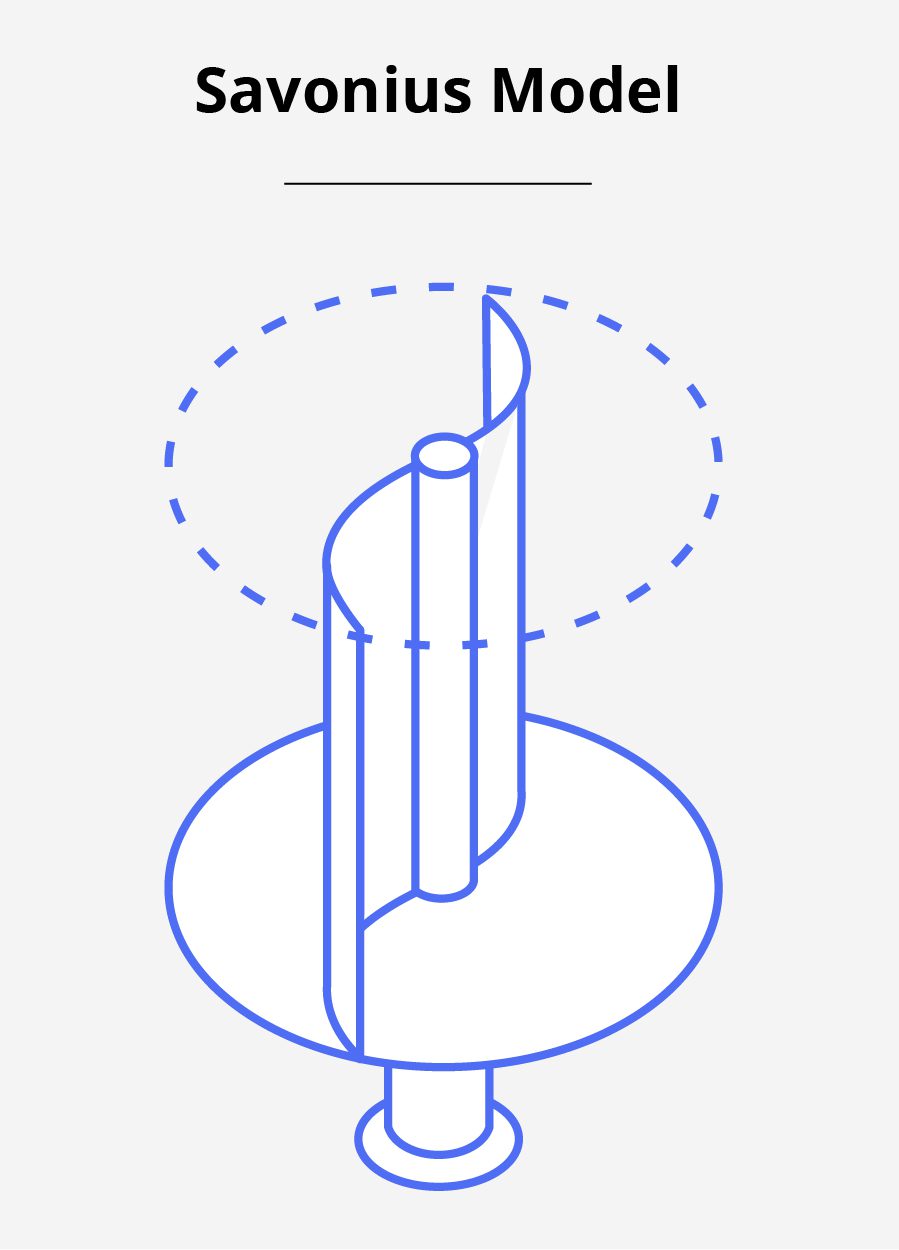
Savonius Model
Named for its inventor, Sigurd Johannes Savonius, the Savonius turbine is a simple model that relies on wind drag. The Savonius wind turbine has been through multiple iterations since the 1920s, but the main concept involves concave and convex surfaces that maintain rotation even during low wind speeds.4 This turbine style is less aerodynamic than other models, but is easy to build and install.5
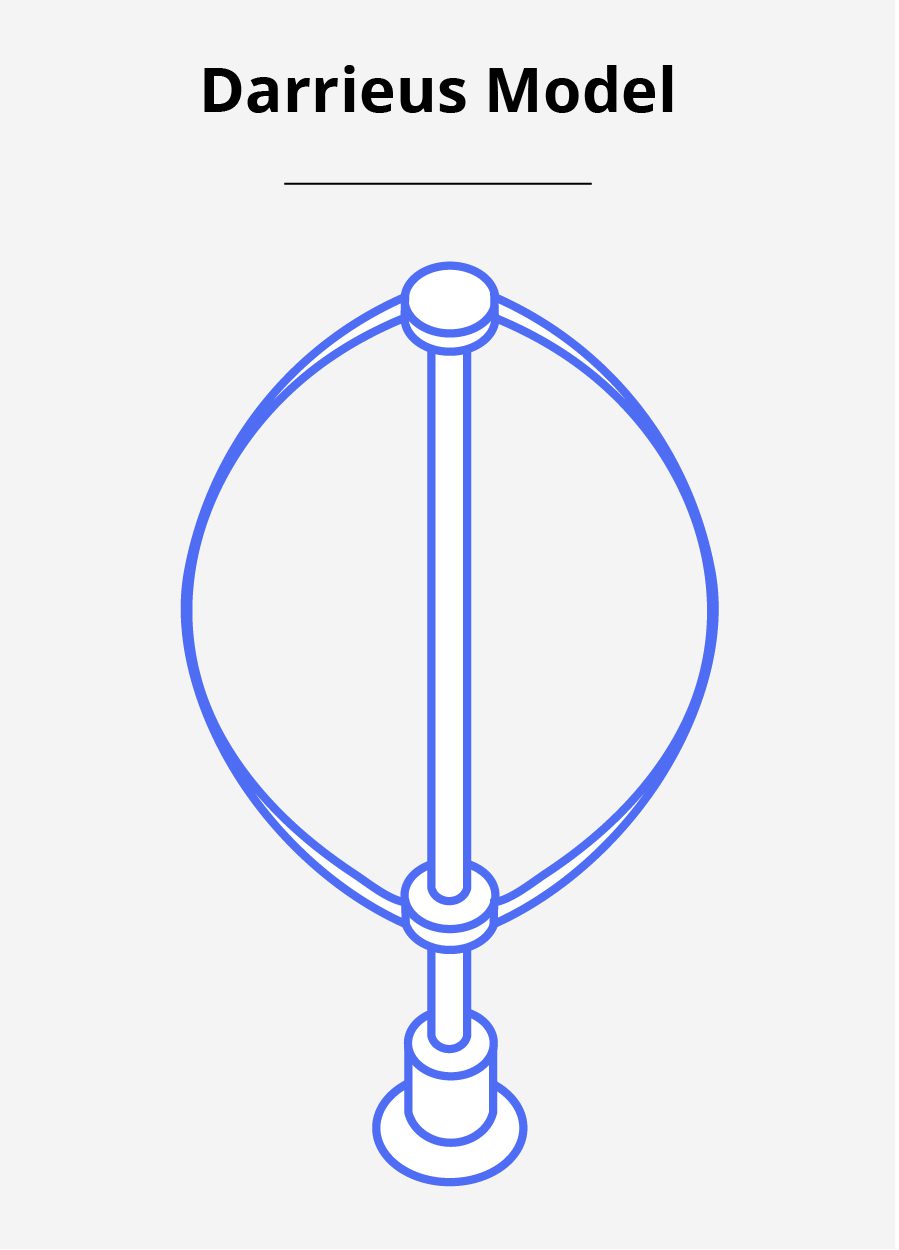
Darrieus Model
Aptly described as having an “egg-beater” shape, the Darrieus wind turbine (patented by Georges Jean Marie Darrieus in 1926) is the most common VAWT. This model relies on wind lift instead of wind drag, bearing some resemblance to horizontal wind turbine blades, but the vertical blades on Darrieus models are less affected by wind direction. Darrieus turbines are more efficient than Savonius turbines, but have more difficulty self-starting and suffer from a weak structure as the vertical rotor puts a significant amount of stress on the turbine base. Other variations of the Darrieus turbine include giromills and helix-shaped models.
Advantages of Vertical-Axis Turbines
One of the main advantages of vertical-axis turbines is their ability to maintain rotation during turbulent weather or low-speed winds. VAWTs are omnidirectional, meaning they don’t need to turn to face the direction of the wind to function. Since the wind turbine generator is at the bottom of the turbine, vertical turbines are far easier to install and maintain. And the blades of the turbine create a much smaller wake than horizontal-axis turbines, allowing more turbines to be installed within close proximity to each other.6
Disadvantages of Vertical-Axis Turbines
Overall, VAWTs are less aerodynamic and far less powerful than HAWTs. They experience higher levels of drag, are considerably smaller, and struggle to self-start.7 Vertical-axis wind turbines have just recently broken into the MW (megawatt) market where horizontal turbines have been making significant strides for decades.
Which type of wind turbine is the best?
Horizontal-axis wind turbines work the best, converting the kinetic energy of the wind into electrical power with far greater efficiency than vertical turbines. However, vertical-axis turbines can sometimes be the better option for electricity generation in urban areas or places with limited access to materials. As modern engineering continues to improve wind turbine performance and iterate on turbine designs, we may see changes in what the most efficient structure looks like. For now, we can expect the popularity of horizontal-axis turbines to continue and move the renewable energy industry forward around the globe.
Planning a wind project? Titan’s heavy haul services include expert route planning and transportation for wind turbines.
Endnotes
1. https://www.energy.gov/eere/articles/wind-turbines-bigger-better
2. https://www.energy.gov/sites/default/files/2023-08/land-based-wind-market-report-2023-edition.pdf
3. https://www.iflscience.com/the-worlds-largest-wind-turbine-has-been-switched-on-70047
4. https://www.sciencedirect.com/science/article/abs/pii/B9780080878720002055
5. https://www.sciencedirect.com/science/article/abs/pii/B9780080878720002055
6. https://www.asme.org/topics-resources/content/vertical-axis-wind-turbines-work-well-together
7. https://www.sciencedirect.com/science/article/abs/pii/S2352710223001535
